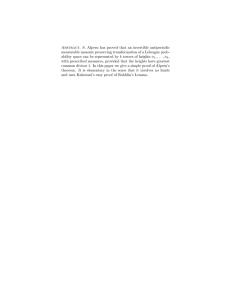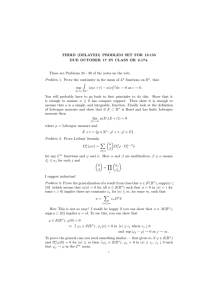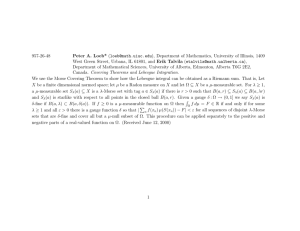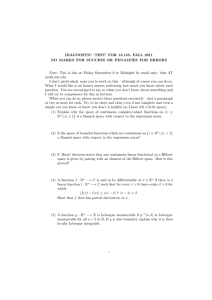D.A. Martin A SIMPLE PROOF THAT DETERMINACY IMPLIES LEBESGUE MEASURABILITY
advertisement
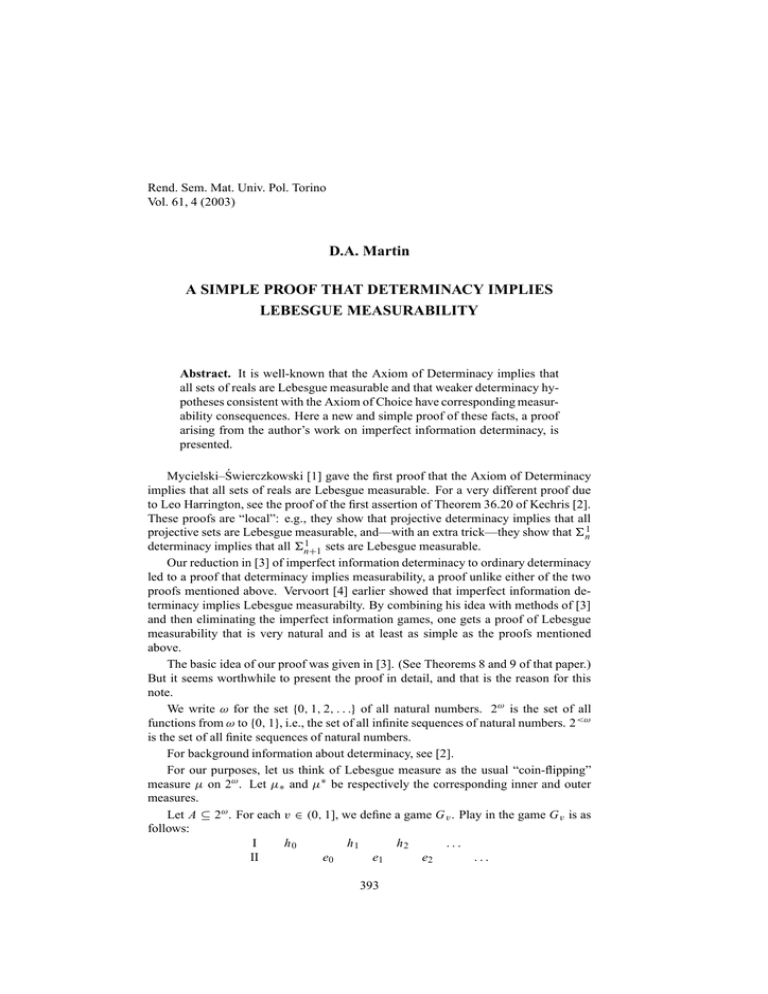
Rend. Sem. Mat. Univ. Pol. Torino
Vol. 61, 4 (2003)
D.A. Martin
A SIMPLE PROOF THAT DETERMINACY IMPLIES
LEBESGUE MEASURABILITY
Abstract. It is well-known that the Axiom of Determinacy implies that
all sets of reals are Lebesgue measurable and that weaker determinacy hypotheses consistent with the Axiom of Choice have corresponding measurability consequences. Here a new and simple proof of these facts, a proof
arising from the author’s work on imperfect information determinacy, is
presented.
Mycielski–Świerczkowski [1] gave the first proof that the Axiom of Determinacy
implies that all sets of reals are Lebesgue measurable. For a very different proof due
to Leo Harrington, see the proof of the first assertion of Theorem 36.20 of Kechris [2].
These proofs are “local”: e.g., they show that projective determinacy implies that all
projective sets are Lebesgue measurable, and—with an extra trick—they show that 6 n1
1
sets are Lebesgue measurable.
determinacy implies that all 6n+1
Our reduction in [3] of imperfect information determinacy to ordinary determinacy
led to a proof that determinacy implies measurability, a proof unlike either of the two
proofs mentioned above. Vervoort [4] earlier showed that imperfect information determinacy implies Lebesgue measurabilty. By combining his idea with methods of [3]
and then eliminating the imperfect information games, one gets a proof of Lebesgue
measurability that is very natural and is at least as simple as the proofs mentioned
above.
The basic idea of our proof was given in [3]. (See Theorems 8 and 9 of that paper.)
But it seems worthwhile to present the proof in detail, and that is the reason for this
note.
We write ω for the set {0, 1, 2, . . .} of all natural numbers. 2ω is the set of all
functions from ω to {0, 1}, i.e., the set of all infinite sequences of natural numbers. 2 <ω
is the set of all finite sequences of natural numbers.
For background information about determinacy, see [2].
For our purposes, let us think of Lebesgue measure as the usual “coin-flipping”
measure µ on 2ω . Let µ∗ and µ∗ be respectively the corresponding inner and outer
measures.
Let A ⊆ 2ω . For each v ∈ (0, 1], we define a game G v . Play in the game G v is as
follows:
I
h0
h1
h2
...
II
e0
e1
e2
...
393
394
D.A. Martin
With each postion in G v of length 2i , we associate inductively vi ∈ (0, 1]. Set v0 = v.
For each i , h i must be a function from {0, 1} to [0, 1] such that
1
1
h i (0) + h i (1) ≥ vi .
2
2
For each i , ei must be a member of {0, 1} such that h i (ei ) 6= 0. Set vi+1 = h i (ei ).
For each position p ∗ in G v , let π( p∗ ) be the sequence
S of all the moves made by II
in arriving at p ∗ . For any play x ∗ of G v , let π(x ∗ ) = i π(x ∗ i ), i.e., let π(x ∗ ) be
element of 2ω consisting of the moves made by II in the play x ∗ . A play x ∗ is a win for
I if and only if
π(x ∗ ) ∈ A.
The idea behind G v is as follows. Player I is trying to show that µ∗ (A) ≥ v. He
begins by asserting lower bounds for µ∗ ({x | h0i_ x ∈ A}) and µ∗ ({x | h1i_ x ∈ A})
which are large enough to imply that µ∗ (A) ≥ v. These alleged lower bounds are
the two values of h 0 . Player II then challenges one of the two by choosing e0 . II is
not allowed to challenge a vacuous assertion that a lower bound is 0. I continues by
asserting lower bounds for µ∗ ({x | he0 , 0i_ x ∈ A}) and µ∗ ({x | he0 , 1i_ x ∈ A}); etc.
L EMMA 1. If I has a winning strategy for G v , then µ∗ (A) ≥ v.
Proof. Let σ be a winning strategy for I for G v .
By induction on the length `h( p) of p, we define the notion of an acceptable p ∈
2<ω , and we associate with each acceptable p a position ψ( p) in G v that is consistent
with σ and is such that `h(ψ( p)) = 2`h( p) and π(ψ( p)) = p. When p is acceptable
and extends q, then q will be acceptable and ψ( p) will extend ψ(q).
The initial position ∅ is acceptable, and of course ψ(∅) = ∅.
Assume that p is acceptable and that ψ( p) is defined. Let h p be the h i given by σ
at ψ( p). For e ∈ {0, 1}, we declare p _ hei to be acceptable just in case h p (e) 6= 0, in
which case we set
ψ( p_ hei) = ψ( p)_ hh p , ei.
For acceptable p, let v p be the v`h( p) of ψ( p). Define f : 2<ω → [0, 1] by
p
v
if p is acceptable;
f ( p) =
0
otherwise.
For p acceptable,
1
1
f ( p_ h0i) + f ( p_ h1i)
2
2
=
≥
=
Note that the inequality
unacceptable p.
1
2
f ( p_ h0i) +
1
2
1 p
1
h (0) + h p (1)
2
2
vp
f ( p).
f ( p_ h1i) ≥ f ( p) trivially holds also for
395
A simple proof
Say that x ∈ 2ω is acceptable just in case all p ⊆ x are acceptable. For acceptable
x, let ψ(x) be the play of G v extending all the ψ(x n). If x is acceptable then x ∈ A,
since ψ(x) is consistent with the winning strategy σ .
The set C of all acceptable x is a closed subset of A. Using the fact that
1
f
(
p_ h0i) + 21 f ( p_ h1i) ≥ f ( p), it is easy to see by induction that, for all n,
2
6`h( p)=n 2−n f ( p) ≥ v.
Since f ( p) ≤ 1 for all p and f ( p) = 0 for unacceptable p, it follows that, for all n,
µ({x | x n is acceptable}) ≥ v.
But this means that µ(C) ≥ v and so that µ∗ (A) ≥ v.
L EMMA 2. If II has a winning strategy for G v , then µ∗ (A) ≤ v.
Proof. Let τ be a winning strategy for II for G v .
Let δ > 0. We shall prove that µ∗ (A) ≤ v + δ.
By induction on `h( p), we define a new notion of an acceptable p ∈ 2 <ω , and we
associate with each acceptable p a position ψ( p) in G v that is consistent with τ and is
such that `h(ψ( p)) = 2`h( p) and π(ψ( p)) = p. When p is acceptable and extends q,
then q will be acceptable and ψ( p) will extend ψ(q).
The initial position ∅ is acceptable, and ψ(∅) = ∅.
Assume that p is acceptable and that ψ( p) is defined. Let v p be the v`h( p) of ψ( p).
For e ∈ {0, 1}, set
u p (e) = inf{h(e) | h is legal at ψ( p) ∧ τ (ψ( p)_ hhi) = e},
where we adopt the convention that inf ∅ = 1.
We first show that
1 p
1
u (0) + u p (1) ≤ v p .
2
2
If this is false, then there is an ε > 0 such that the move h given by h(e) = u p (e) − ε
is legal at ψ( p), an impossibility by the definition of u p .
We define p_ hei to be acceptable just in case u p (e) 6= 1. For e such that p _ hei is
acceptable, let h p,e be legal at ψ( p) and such that
h p,e (e) ≤ u p (e) + 2−(`h( p)+1)δ and τ (ψ( p)_ hh p,e i) = e.
Then set
ψ( p_ hei) = ψ( p)_ hh p,e , ei.
For e such that p _ hei is not acceptable, let h p,e = 1. Note that the inequality h p,e (e) ≤
u p (e) + 2−(`h( p)+1)δ holds for these e also.
396
D.A. Martin
Define f : 2<ω → (0, 1] by
f ( p) =
vp
1
if p is acceptable;
otherwise.
For acceptable p with `h( p) = n,
1
1
f ( p_ h0i) + f ( p_ h1i) =
2
2
1 p,0
1
h (0) + h p,1 (1)
2
2
1 p
1
≤
(u (0) + 2−(n+1) δ) + (u p (1) + 2−(n+1) δ)
2
2
≤ v p + 2−(n+1) δ
= f ( p) + 2−(n+1) δ.
Note that the inequality 12 f ( p_ h0i) + 12 f ( p_ h1i) ≤ f ( p) + 2−(n+1) δ holds trivially
for unacceptable p with `h( p) = n.
As before, say that x ∈ 2ω is acceptable just in case all p ⊆ x are acceptable. For
acceptable x, let ψ(x) be the play of G v extending all the ψ(x n). If x is acceptable
then x ∈
/ A, since ψ(x) is consistent with the winning strategy τ .
The set C of all acceptable x is a closed subset of the complement of A. It is easy
to see by induction that, for all n,
6`h( p)=n 2−n f ( p) ≤ v + (2n − 1)δ/2n .
Since f ( p) ≥ 0 for all p and f ( p) = 1 for unacceptable p, it follows that, for all n,
µ({x | x n is unacceptable}) ≤ v + (2n − 1)δ/2n .
But this means that µ(C) ≥ 1 − v − δ and so that µ∗ (A) ≤ v + δ.
Note that the proofs of both our lemmas go through unchanged if we modify G v so
that the values of the h i are required to be rational.
If all G v are determined, then the given set A is Lebesgue measurable and
µ(A) = sup{v | I has a winning strategy for G v }.
Thus our arguments show that AD implies that all sets are Lebesgue measurable. Moreover the complexity of the G v is essentially the same as that of A, so our proof is “local”
in the sense mentioned earlier.
References
[1] M YCIELSKI J. AND Ś WIERCZKOWSKI S., On the Lebesgue measurability and
the axiom of determinateness, Fund. Math. 54 (1964), 67–71.
A simple proof
397
[2] K ECHRIS A.S., Classical descriptive set theory, Springer-Verlag, New York
1994.
[3] M ARTIN D.A., The determinacy of Blackwell games, Jour. Symb. Logic 63
(1998), 1565–1581.
[4] V ERVOORT M.R., Blackwell games, in: “Statistics, probability, and game theory:
papers in honor of David Blackwell”, (Eds. Ferguson T., Shapley L. and McQueen
J.), IMS Lecture Notes-Monograph Series 30, Institute of Mathematical Statistics
1996, 369–390.
AMS Subject Classification: 03E60, 03E15, 28A05.
Donald A. MARTIN
Department of Mathematics
UCLA
Los Angeles CA 90095-1555
e-mail: dam@math.ucla.edu
Lavoro pervenuto in redazione il 03.12.2003.
